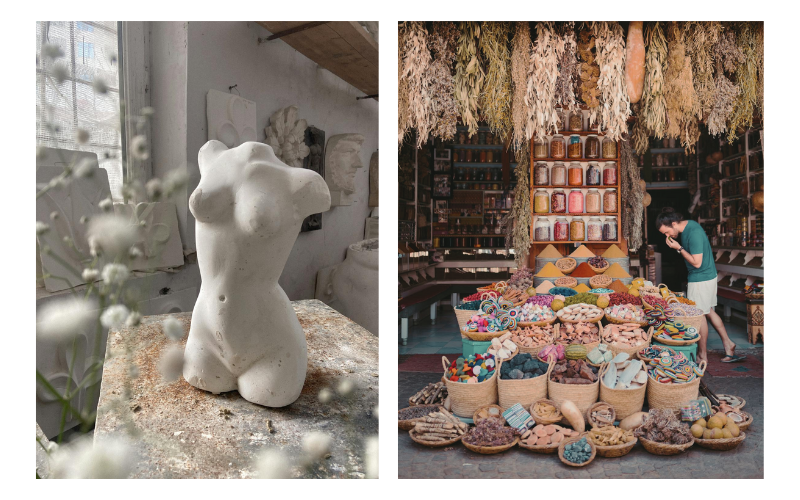Imagine a brand that not only offers great products or services but also seems to know exactly what you find delightful and which experiences make you feel good. This is the power of aesthetic empathy – a secret ingredient that sets some brands apart from the rest.
When talking about aesthetics, I’m talking about sensory delight. It derives from the Greek word “estetiko” and it’s about perceptual power and awareness of the senses.
Aesthetic empathy is the ability to step into your customers’ shoes and understanding what they find visually appealing, what sounds and smells evoke positive emotions, and what textures and flavors they find irresistible. When a brand masters this art, it creates a deep emotional connection with its audience, increasing loyalty and advocacy like no other.
In this article, we’ll take a deep dive into the world of aesthetic empathy. We’ll explore real-life examples of brands that have mastered this art and we’ll provide you with practical tips and exercises to help you strengthen your own aesthetic empathy muscles.
Proven Systems for Business Owners, Marketers, and Agencies
→ Our mini-course helps you audit and refine an existing brand in 15 days, just 15 minutes a day.
→ The Ultimate Brand Building System is your step-by-step blueprint to building and scaling powerful brands from scratch.
Table of Contents
Defining Aesthetic Empathy
It’s essential to understand that aesthetics is not solely about beauty. While it can be beautiful, that’s not its core essence.
Aesthetics, by definition, is related to the perception of the senses: how things look, feel, sound, taste, and smell to an individual. Aesthetic empathy involves understanding and interpreting what delights others in terms of sensory experiences, how they respond to various stimuli, and what you can do to heighten their sense of delight and anticipation even further.

So, what sets aesthetic empathy apart from the regular concept of empathy as we know it?
Regular empathy, as we commonly understand it, is a passive notion. It’s about recognizing and understanding others’ emotional states.
Aesthetic empathy, in contrast, is a more active and imaginative process. It involves attuning yourself to others’ preferences and using your creativity to elevate their experiences in a way that is valuable and meaningful to them. It goes beyond merely understanding their emotions; it’s about grasping what truly delights them and finding ways to amplify that delight to create a more engaging and memorable experience.
How To Become More Aesthetically Empathetic?
To develop aesthetic empathy, one must be attuned to the present moment and the experiences unfolding around them. Cultivating your own aesthetic intelligence can greatly enhance your capacity for aesthetic empathy. This process is highly introspective and self-focused, requiring you to embark on a journey of self-discovery and expression.
Here are some exercises to strengthen and develop your aesthetic tastes:
- Conduct a sensory audit for yourself: Begin by engaging your intuitive system and conducting a sensory audit that encompasses all five senses. Explore the emotions evoked by different colors, foods, scents, melodies, sounds, and tactile sensations. Each sense triggers an emotional response through the release of hormones or neurotransmitters, such as endorphins, oxytocin, serotonin, adrenaline, and dopamine.
- Expose yourself to new types of art: Art is a very important way to enhance aesthetic empathy. Try to expose yourself to new types of art, and take notice of how this makes you feel.
- Create sensory moodboards: Working on a sensory mood board of your memories and sensations can be very interesting and helpful. Think about what feels good to you or not (and why)?
- Immerse yourself in new environments: Come up with practices to remove yourself now and then from your usual distractions. Give yourself space, immerse yourself in different environments, try new sensory experiences, and discover things in new ways.
- Learn from what you enjoy and what you don’t enjoy: I encourage you to discover new things to improve your confidence. Creativity comes by inspiring yourself with variable inputs: things you like and also things you don’t like.

As you become more attuned to your own sensory cues and curate your personal sensorial landscape, you develop a heightened perception that allows you to stimulate others through aesthetic cues. By strategically employing aromas, textures, shapes, and colors, you can unleash your creativity in ways that elevate their senses and arouse associative and emotional connections.
For example, even people like Steve Jobs, who was not known for being very sensitive to other’s feelings in job meetings, can target their sensitivity to what delights others for the development of products and give a lot of thought to how the design of products, spaces or campaigns can lift people. Using imagination and the ability to replicate that in very effective ways constitute how aesthetic empathy leads to success.
Real-Life Examples of Brands Leveraging Aesthetic Empathy
In recent years, several forward-thinking brands have been experimenting with aesthetic empathy to enhance their offerings and create more delightful, engaging experiences for their customers. By carefully crafting multisensory environments, these brands aim to evoke specific emotions and leave a lasting impression on their audiences.
Google’s “A Space for Being” Exhibition
Google, in collaboration with leading scientists, has showcased the profound impact of aesthetic experiences on our health and well-being through their innovative “A Space for Being” exhibition. By meticulously designing rooms with varying lighting, sounds, scents, and textures, the exhibition stimulates visitors’ senses in unique ways, demonstrating how neuroaesthetics and the right combination of elements can positively influence our state of mind.
IKEA and SONOS: Combining Sound and Furnishing
IKEA, the world-renowned furniture retailer, has partnered with SONOS, a leading sound system manufacturer, to create the SYMFONISK table lamp. This ingenious product seamlessly integrates light and sound into a single, compact device, helping to declutter homes by reducing the number of devices and cords needed. By merging two essential elements of home decor, IKEA and SONOS have created a product that appeals to both the visual and auditory senses, enhancing the overall aesthetic experience.

The Ritz-Carlton’s Multisensory Brand Experience
The Ritz-Carlton, a luxury hotel chain, is known for its commitment to creating unforgettable experiences for its guests. As part of their brand identity, the company invests in a multisensory approach, incorporating specific scents and sounds across their properties. In Bangalore, they have taken this concept to new heights with the introduction of “Dineamation”, an immersive dining experience that fuses culinary delights with captivating entertainment. By engaging multiple senses, The Ritz-Carlton aims to create a deeper connection with their guests, ensuring that their stay is both memorable and emotionally resonant.
The Benefits of Aesthetic Empathy for Brands
Brands that excel in aesthetic empathy can differentiate themselves by forging strong emotional bonds with their target audience, leading to a multitude of advantages:
- Higher Pricing Power
Aesthetic empathy gives you pricing power. Emotions are a decision-making key to driving customer behavior. Thus, your customers are happy to pay for it.
- Elevated Brand Experience
By understanding and catering to the sensory preferences of their target audience, brands can create memorable and delightful experiences that set them apart.
- Brand Differentiation
Only a few companies in each sector know how to leverage aesthetic empathy effectively. By doing it well with authenticity and confidence, you can set your brand apart from the competition.
- Enhanced Brand EquityBrand equity represents the value of a brand. It is the difference between the value of a branded product and the value of that product without that brand name attached to it. More
Strengthening the emotional connection with customers through aesthetic empathy can increase brand value and create lasting memories.
- Loyalty and Business Performance
Aesthetic empathy can lead to loyalty. People are more likely to return to brands that consistently provide delightful experiences. If you can bring joy to your customers and other stakeholders through your products, communication, and kindness, they will return, leading to improved financial performance.
Balancing Aesthetic and Commercial Imperatives
Brands always face some level of conflict between the aesthetic imperative and the commercial imperative. By commercial, I mean the financial and operational goals and the willingness to be more efficient with a lower cost. As a commercial entity, working to be faster is frequently challenged and opposed to taking the time to do what
is built to last artistically – which is on the aesthetic side. These two facets are driven by different outcomes: the commercial objective is about profit and revenues, and the aesthetic imperative is about customer resonance and a creative concept that stands out from the crowd.
When the customer is not happy and isn’t feeling the connection with the
brand, at the end of the day, the investor is not going to be satisfied either. These two forces have different time horizons. The aesthetic imperative takes time to do and is a long-term investment. Often, what we do in the short term in a company will take time to pay off, but the commercial objectives are generally measured over a
smaller period.
A healthy balance to drive this conflict leads to a successful brand. If a company is too aesthetic and focused on emotional resonance, artistry, or originality- it won’t be viable to support the practical element.
The best leaders do not try to resolve the tension between the aesthetic and commercial imperative. They try to balance it.
Key Takeaways
Aesthetic empathy is a powerful tool for brands to create meaningful connections with customers by understanding and catering to their sensory preferences and emotional needs. This sets brands apart, increases loyalty, and can improve the overall brand experience.
To excel in aesthetic empathy, brands must balance the aesthetic imperative with the commercial imperative of financial viability and operational efficiency. The most successful brands harmonize these forces, aligning their aesthetic pursuits with business goals.
In an age of artificial intelligence, the ability to empathize with and delight customers through aesthetic experiences remains a uniquely human advantage.









